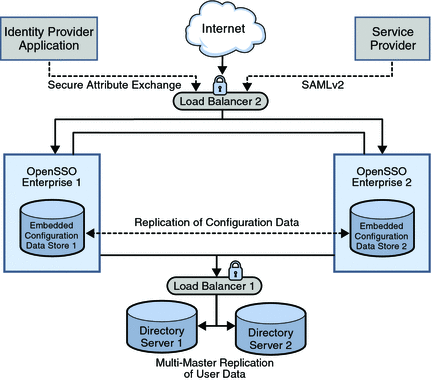1.2.1 Identity Provider Deployment
An identity provider specializes in providing authentication services. As the administrating service for authentication, an identity provider maintains and manages identity information. It establishes trust with a service provider in order to exchange user credentials, enabling single sign-on between the providers. Authentication by an identity provider is honored by all service providers with whom the identity provider is partnered. The identity provider domain is idp-example.com. The following image illustrates the identity provider architecture in this deployment.
Figure 1–1 Identity Provider Deployment Architecture

The identity provider domain in this deployment is idp-example.com. The identity provider application represents a legacy system which relies on OpenSSO Enterprise to act as a secure gateway through which identity information can be transferred to another application in a different domain. This functionality is provided by the Secure Attribute Exchange feature of OpenSSO Enterprise which uses SAML v2 without having to deal with federation protocol and processing.
The following list of components will be installed and configured on the identity provider side using the procedures documented in Part II, Building the Identity Provider Environment.
- Sun OpenSSO Enterprise
-
Two instances of OpenSSO Enterprise provide the core functionality. Each instance is created with a configuration data store. Configuration data includes information about services, administrative users, realms, policies, and more. Two instances of Sun Java System Application Server are installed on the OpenSSO Enterprise host machines into which the OpenSSO Enterprise WAR is then deployed.
Note –User data is accessed through a single load balancer deployed in front of two instances of Sun Java System Directory Server.
- Sun Java System Directory Server
-
Two instances of Directory Server provide storage for user entries that will be created for testing this deployment. Both instances of Directory Server are masters that engage in multi-master replication, providing high availability to the OpenSSO Enterprise layer.
Note –The command line is used for all Directory Server configurations in this guide.
- Load Balancers
-
The load balancer hardware and software used for this deployment is BIG-IP® manufactured by F5 Networks. They are deployed as follows:
OpenSSO Enterprise Load Balancer. This load balancer exposes the web-based OpenSSO Enterprise console to internal administrators. Alternatively, internal administrators can bypass this load balancer and log in directly.
Directory Server Load Balancer. The load balancer in front of the Directory Server instances provide round-robin load balancing and a single virtual Directory Server host name. It detects individual Directory Server failures and recoveries, taking failed servers off the load balancer list.
- © 2010, Oracle Corporation and/or its affiliates
